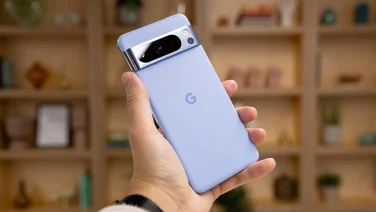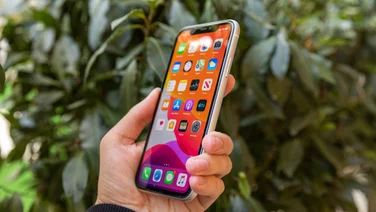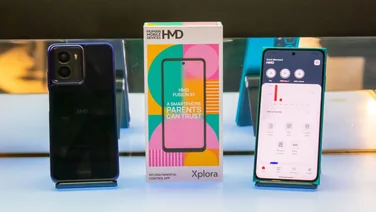To help us provide you with free impartial advice, we may earn a commission if you buy through links on our site. Learn more

- Good software implementation
- Fast performance
- Mediocre battery life
- Full HD display-only
Released mid-2015, the HTC One M9 had to compete with the likes of the Samsung Galaxy S6 and S6 Edge; in 2018, it has fresh competition from the likes of the Motorola Moto G6, which at the time of updating this review costs £200 – coincidentally, so does the One M9.
So, is the One M9 worth it, or has this three-year-old smartphone past its sell-by date? Well, if you’re looking for snappy performance, solid build quality and a decent camera to boot, the HTC is a fantastic choice. If you’re looking for a more elongated screen, a closer-to-stock Android experience and a fast-charging device; you’d be better off getting the newer Moto G6 instead.
If you want to know more about the One M9, continue reading Katharine’s review, below.
Prior to the HTC One M9 and HTC 10, the stunning One M8 set the standard for HTC’s products. Since the One M8’s release, its successors, including the One M9 have a similar design. That’s not to say that the One M9 isn’t a beautiful-looking phone, but it doesn’t have the same ‘wow factor’ as some of HTC’s previous flagship handsets or even the Samsung Galaxy S6 and S6 Edge, that standout.
It also doesn’t help that the HTC One M9 has exactly the same kind of display as the One M8. Rather increasing the resolution to 2,560 x 1,440, the One M9 has a 5in, 1920 x 1,080 display – where if you want an HTC phone with a higher-end display, you’ll have to go for the newer HTC 10.

^ Looking at the One M9 (left) and One M8 (right) side by side, you’d be hard pushed to tell them apart
HTC One M9 review: Design and build quality
Staying the same isn’t necessarily a bad thing, as the small refinements HTC has made to the One M9 make it an instantly more appealing handset than its predecessor. For instance, it’s now far more angular around the edges and the distinct lip around the side of the phone makes it much easier to grip and hold securely – unlike the One M8 which constantly felt like we were about to drop it.
HTC has also added a dash of colour into the phone’s frame, taking inspiration from luxury watches and fine jewellery. It’s a similar idea to what we’ve seen from the HTC Desire Eye, which had an additional band of colour infused directly into the phone’s soft-touch chassis. Here, the same effect has been applied to the One M9, only with metal instead of plastic.

^ The One M9 has more angular edges than the One M8, making it easier to hold and grip
It’s a subtle effect, but one that really adds a touch of class to the handset, making it look and feel even more like a premium handset compared to last year’s model. Our review sample was a fetching silver and gold model, but it’s also available in a darker gunmetal grey with mirrored grey side-walls and a gold version with mirrored polished gold side-walls.
Other small flourishes include a machined finish on the power button much like that on the Nexus 6 and 2nd Gen Moto X and a sapphire glass camera lens. Naturally, the back has a scratch-resistant coating, but several contract providers are currently bundling in free DotView cases with transparent backs so you can still see the phone’s metal chassis. There will also an IPX68-rated waterproof DotView case available, so you can use it in the bath or a heavy rain shower without it taking damage.

^ A variety of DotView cases will be available for the One M9, but many of them now let you see the metal underneath instead of hiding it away
Of course, none of these are particularly compelling reasons to upgrade if you already own an M8, but for those in the market for a new contract, it’s certainly got the legs to go head-to-head with either the Samsung Galaxy S6 or Galaxy S6 Edge. Despite being thicker and heavier than Samsung’s Galaxy S6, measuring 144x70x9.6mm and weighing 157g compared to the S6’s 143x70x6.8mm and 138g, it’s easily just as attractive.
HTC One M9 review: Android 5.0 and Sense 7
Note: Since our initial review, the One M9 has received a free upgrade, to Android 7 Nougat.
We really like HTC’s new Sense 7 interface. We weren’t big fans of Sense 6, but Sense 7 really benefits from Android 5.0’s Material Design scheme, as its flatter, cleaner look and fatter, more rounded fonts look much more pleasing to the eye.
It’s a far more personal Android skin that any of HTC’s previous interfaces, as its brand-new Theme Generator will revamp the entire handset right down to your phone’s app icons, sounds, fonts and caller ID logo if you don’t like the default colour scheme. A handful of themes will come pre-installed (with more available to download from HTC’s Theme Store), but you can also use pictures from your own gallery to help define the look of your handset.

It works by analysing the colours present in your chosen wallpaper and will then suggest various different tones and colours you can use as the basis for your home screen, Blinkfeed and settings menu. It’s a great touch, but you can always tweak things individually if you don’t like what you see. It worked extremely well when we tried it out for ourselves, as even a shot of a largely green hedge gave us plenty of different options to choose from, so you don’t need to have anything particularly colourful or busy to get the perfect personalised look.
We also like that you can add another shortcut button to the lower navigation bar. For instance, as well as the usual Home, Back and Recent Apps buttons, you can add a shortcut for quick settings or notifications. You can also have a shortcut to turn off the screen, hide the navigation bar and lock the screen’s auto-rotate function, all of which add another layer of convenience to the handset.

^ A handful of pre-installed themes will be available out of the box, but you can download more for free from HTC’s Theme Store
Much to our relief, HTC’s also revamped its Motion Launch gestures. These allow you to automatically activate certain features with simple finger swipes when the phone’s screen is turned off, but on the One M8 you either had to turn them all on or disable them completely. Luckily, the One M9 lets you choose which ones you want to have active, so you’ll never again accidentally unlock your phone when you’re trying to fish it out of a pocket and move your finger up the screen.
Sense Home is another new feature and learns which apps you use most in certain locations and then promotes those apps to the front home screen when you need them. For instance, when we were in the office we were presented with our Mail, Google Drive, Calendar and HTC’s note-taking Scribble apps. On our way home, though, it swapped these for Google Maps and HTC’s Music and Car apps.
You can still pin apps to the home screen so they don’t disappear, but it should certainly help reduce the amount of app clutter clogging up your various home screens. Likewise, if you’re near certain locations such as a station, Sense Home can suggest other relevant apps such as train timetables or route planners in the Suggestion folder. Taken together, Sense 7 is a vast improvement on Sense 6 and it greatly adds to the overall appeal to the handset.
HTC One M9 review: Performance
With its octa-core 2.0GHz Qualcomm Snapdragon 810 processor and 3GB of RAM, the HTC One M9 has plenty of power behind it, too. It got quite toasty while we were running our benchmarks, but it was never uncomfortably hot and it soon returned to cooler temperatures once we went back to browsing the web.
In BaseMark OS II, its overall score of 1,463 puts it comfortably in front of the Nexus 6, but it lagged behind both of Samsung’s Galaxy S6 and S6 Edge handsets, which scored 1,643 and 1,845 respectively. The same was true of the One M9’s graphics performance. Whereas the One M9 scored 28,074 in our BaseMark X 1.1 graphics benchmark (averaging 30.6fps in the Dunes test and 42.9fps in the Hangar test), the S6 and S6 Edge scored a massive 31,157 and 37,885.
It’s not as fast as the S6 and S6 Edge, then, but web browsing on the One M9 was still supremely smooth as we were able to scroll up and down sites with hardly any judder at all. Panning around and zooming in were also fast and responsive, although we rarely felt the need to do so unless we were browsing desktop sites.

HTC One M9 review: Display
Where the One M9 starts to fall behind, at least on paper, is its 5in 1,920×1,080 display. Admittedly, a Full HD display is still perfectly acceptable by modern smartphone standards, as videos look much sharper on a 1080p screen than they do upscaled to 2,560×1,440, and the main home screens are still perfectly sharp and easy to see.
However, while 1080p is still practical, the One M9’s image quality is relatively poor. For instance, our colour calibrator showed it was only displaying 87.1% of the sRGB colour gamut, which is almost 10% less than we’d normally expect to see from an LCD panel. Its weakest area was its warm colour coverage, which fell quite a long way short of the sRGB gamut boundary. This had the effect of making images appear a little cool when compared to one of Samsung’s Super AMOLED displays, for example, but at least the One M9’s contrast ratio of 1,356:1 helped provide plenty of detail.
Black levels were around average, measuring 0.35cd/m2, and the screen’s peak brightness of 478.50cd/m2 ensured that whites were clean and pure. This is more than enough to comfortably use the phone outside, and just below half brightness still provided plenty of clarity indoors as well.
HTC One M9 review: Battery life
For our battery life test, we set the screen brightness to 170cd/m2, which is just above halfway on the phone’s brightness slider. Playing a continuous video on loop, the One M9’s 2,840mAh battery lasted 9h 13m, which isn’t spectacular by modern standards but should still be enough to get you through the day. However, once again, it pales in comparison to the S6 and S6 Edge, which lasted 13h 37m and 15h 33m under the same conditions.

HTC One M9 review: Storage
Unlike the Galaxy S6, which is available in separate 32GB, 64GB and 128GB versions, the One M9 only has 32GB of onboard storage. However, you do get a microSD card slot with the One M9, allowing you to expand the phone’s internal storage up to 128GB if necessary. We prefer this, as it makes the phone both more flexible and cheaper in the long run, as you don’t have to fork out more money up front for a higher capacity handset.
HTC One M9 review: Camera
When the One M8 first launched, we were pleasantly surprised by its 4-megapixel ‘Ultrapixel’ Duo Camera, but as time wore on it became increasingly clear that its smeary low res shots simply weren’t up to the task of competing with other flagship phone cameras. Sadly, the One M9’s rear camera has also become something of a disappointment, despite the fact that it now has a much higher 20-megapixel sensor and dual LED flash.
As you’d expect, the level of detail present in both the foreground and background is a huge improvement on the M8, and our test images remained sharp throughout. However, the camera’s exposure levels are all over the place, and even HTC’s latest software update to version 1.40.401.8 which began rolling out in June hasn’t really delivered any significant improvements. This particular update is meant to improve the camera’s auto-exposure balance algorithm to enhance the sensor’s overall dynamic range, as well as improve its low-light capabilities, allowing the camera to capture more detail and produce more realistic colours.
When we first started testing the phone’s camera, areas of shadow were very dark indeed, resulting in very dingy-looking photos. Likewise, manually adjusting the main focus point tended to make the rest of the photo appear too bright, whiting out the sky and surrounding buildings. Things are a little better with the recent software update, but photos are still overly dim compared to its main rival, the Galaxy S6.

^ Even in sunny weather, areas of shadow were far too dark if we didn’t manually adjust the focus point

^ By way of comparison, this is the same view taken on the Galaxy S6 at exactly the same time, which is much brighter and better exposed
Luckily, we found that switching to HDR mode helped reduce this problem, as it brought large areas of shadow into view without making them look unnaturally lit. Colours remained accurate as well, albeit at the expense of an overexposed sky. It’s a shame that this flagship handset can’t properly expose an outdoor image; still, we’d prefer to have a white sky than be drowning in shadow, so if you’re shooting outdoors, we’d recommend switching to HDR mode in more overcast weather conditions.
Indoors, there’s slightly better news, as colours were indeed much richer and better exposed – as promised by the latest software update. Our test images were reasonably sharp, too, but they were still noticeably darker than those we took with the S6. As a result, the lack of contrast meant that some textures, such as the fur on our teddy bear, didn’t look quite as defined, and the gleaming statue towards the back looked positively tarnished by comparison.

^ Despite its continuing poor performance outdoors, we were reasonably pleased with the One M9’s indoor capabilities

^ However, the One M9 still can’t compare to the Galaxy S6, which had buckets more contrast and brighter, richer colours
While the 1.40.401.8 update was a full ROM update, HTC has also added its M9 Camera app to the Google Play Store this year, meaning it can push smaller updates out to users much sooner than before, and one of the most notable so far is the ability to add RAW capture.
RAW shooting is becoming a much bigger deal on smartphones than it used to be, as the sensors inside each handset are capable of producing very detailed shots, but you’ll need to export your images and tweak them using desktop image editing software like Adobe’s Lightroom. The One M9’s RAW images aren’t sharpened or processed in the same way as its JPEGs, which helps preserve detail and lets you adjust levels, exposure and white balance in a non-destructive way. It takes around a second for the phone to take a RAW photo, and the results are undoubtedly noisier, but details are preserved and you can get a better final image with only a small amount of adjustment in software.

^ RAW .dng file exported as .TIFF (left) compared with JPEG (right)
In our 150% cropped reference image, it’s clear that the HTC One M9 is applying a great deal of noise reduction and sharpening to its JPEG images, which aren’t present when shooting in RAW. There’s visible JPEG compression around the samurai’s helmet on the right image, and the colours have been warped slightly. With minimal adjustment, the RAW file should make for a superior final image.
HTC One M9 review: Verdict
The HTC One M9’s design is once again a very much by-numbers update, but HTC’s new Sense 7 interface gives the One M9 a new lease of life, making it feel anything but a tired rehash of year-old ideas. Admittedly, its battery life and overall screen quality aren’t quite as good as we expected, and the camera continues to lag behind the competition, but there’s still a lot to like here, particularly if you’ve been disappointed with the One M8.
It may not be quite as powerful as Samsung’s top-end phones, but at least it’s equally as attractive. However, the worry is that HTC hasn’t improved the hardware enough to really compete, especially when the Galaxy S6 and S6 Edge have had significant and wide-sweeping changes. The HTC One M9 is a powerful and attractive flagship Android phone, but the issues with the camera and the quality of the screen hold it back.






